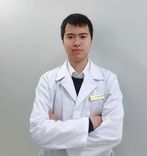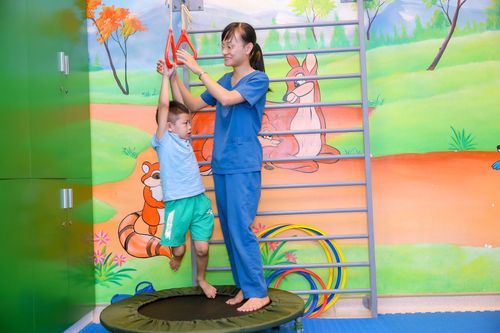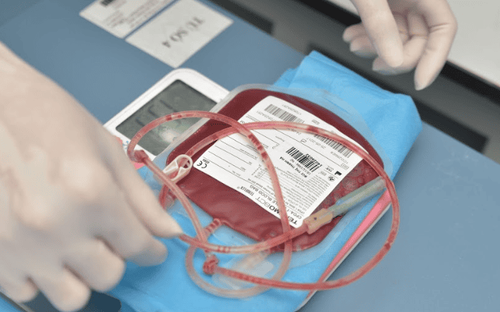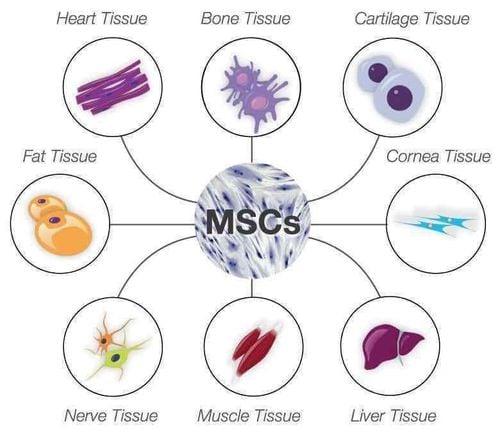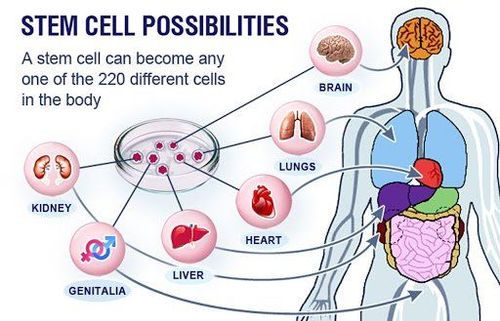This is an automatically translated article.
Article written by MSc.Nguyen Tien Lung - Cell Therapy Block, High-Tech Center
Storing milk tooth marrow stem cells helps parents have more options in preserving stem cells for children aged 5-12. This article helps us understand more about the procedure, international standards for storing milk tooth pulp stem cells, as well as notes for children when teeth are loose to ensure the quality of stem cells.
1. Meaning of milk tooth pulp stem cells storage
Baby teeth are the first set of teeth in development in humans and mammals, playing an important role in eating, speaking, aesthetics and making room for permanent teeth to erupt later. Most children begin to have loose baby teeth between the ages of 5-6 (it can be earlier or later) and by the age of 11-12 have completed the replacement of 20 baby teeth with permanent teeth.Normally, lost teeth are discarded, but stem cells can be extracted from its pulp. These are young stem cells, which are better able to proliferate and form specialized cell types than adult sources. After long-term cryopreservation, they retain their original biological properties, so they can be stored for future use. Like stem cells obtained from stem cells from umbilical cord, adipose tissue or bone marrow, milk tooth marrow stem cells have great potential in regenerative medicine for the treatment of neurological diseases (Alzheimer's, Parkinson's, trauma, etc.) spinal cord injury,...), autoimmune diseases (diabetes, lupus erythematosus, rheumatoid arthritis), cardiovascular disease, cancer,... Therefore, the storage of milk teeth stem cells should be done. (especially for those who have not yet stored umbilical cord stem cells at birth) to have a backup source of cells later.
2. Milk tooth pulp stem cells storage process
When a child's teeth begin to loosen or before, parents can register to store stem cells from baby teeth at service providers. Ignoring administrative processes that may vary from facility to facility from time to time, this article only covers technical issues that help us better understand the steps from sending a tooth sample to receiving stem cells. storage.
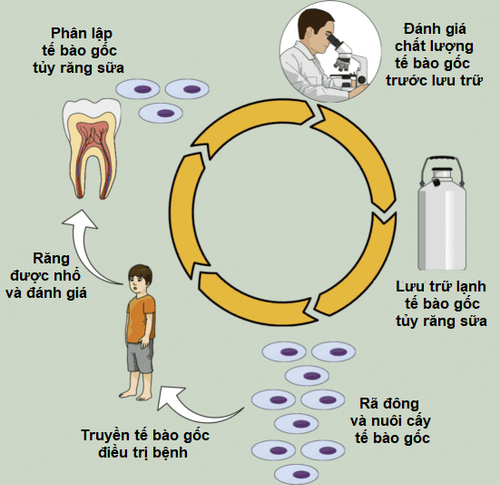
Diagram of the storage process of milk tooth pulp stem cells. Teeth after extraction or natural fall are preserved in a transport solution and sent to a storage facility. Stem cells were isolated from tooth pulp, cultured and evaluated for quality before cryopreservation. In the future, when a child or other person has health problems that can be treated with stem cells, the sample is thawed and cultured before being transferred back to the patient.
2.1. Collecting Samples Baby teeth are a natural product of the tooth replacement process and are extracted or fall out on their own when loose. Therefore, the collection of teeth for stem cell isolation does not require any further intervention in the child. Teeth after extraction or loss should be cleaned, disinfected and immediately transferred to a specialized transport solution. If not timely, the marrow quickly loses moisture, changes in osmotic pressure, ... leading to marrow death, unable to separate stem cells. Therefore, parents should note that when taking their children to have their teeth extracted, they need to notify the storage facility in advance to prepare for timely and timely sample collection. In the unexpected case, teeth are broken, lost or extracted when no staff comes to collect, parents need to urgently notify the storage facility for instructions on appropriate handling measures, but the possibility of success When separating stem cells will be significantly reduced.
Another matter of concern is that the milk teeth collected should be normal teeth, without special dental interventions (such as dental fillings), without tooth decay, pulpitis. In many cases, the samples look similar to a healthy tooth, but when the pulp is removed, inflammation is detected. According to studies in the world and at Vinmec, teeth with caries or pulpitis have a high risk of infection, and stem cells cannot be isolated.
In addition, the test results at Vinmec also show that tooth position greatly affects the ability to isolate stem cells. The incisors and canines have narrow and shallow pulp chambers, so the pulp is often better preserved after extraction, the success rate of stem cell separation is high (in which the incisors are larger in size, the pulp volume is more than the canines). making it easier to obtain stem cells).
Molars have a wide and shallow pulp chamber, when the teeth are loose, they are often stuck with food or dirt, easily attacked by bacteria, even the pulp may be retained in the jaw when the tooth is extracted. So, although children have up to 20 baby teeth for parents to consider, the decision to store should be made early, because the incisors are usually replaced first, as the child gets older, the number of baby teeth decreases. and only molars remain, from which the chances of obtaining stem cells are reduced.
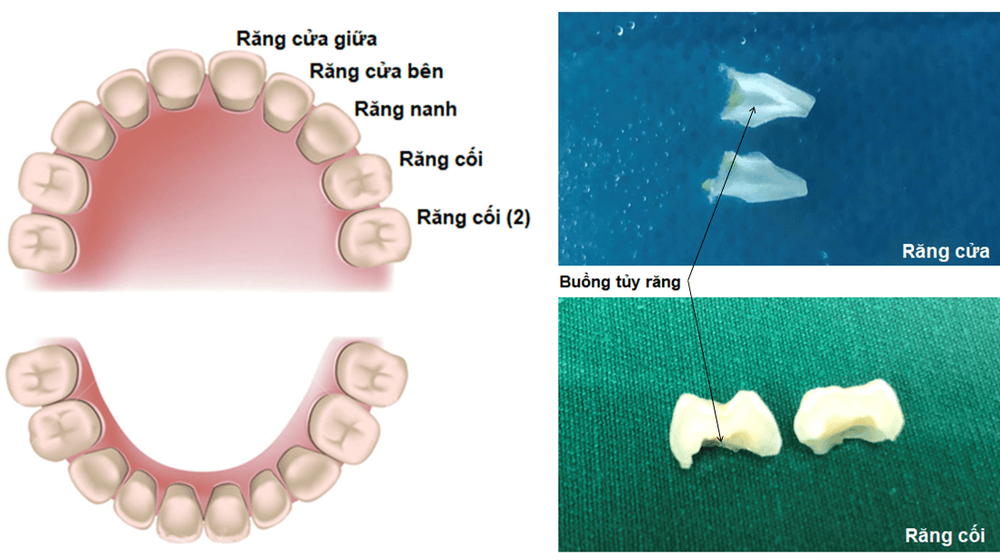
Incisors and canines have narrow and deep pulp chambers, so the pulp is well preserved; molars have a wide and shallow pulp chamber, the pulp is often not well preserved, even losing pulp after tooth extraction.
2.2. Isolation and culture of stem cells After collection, baby teeth are quickly transferred to the processing site for stem cell isolation. The pulp is separated from the tooth, separated from the stem cells and cultured under special conditions. After about 20-30 days of culture, the number of stem cells increases rapidly and is sufficient for cryopreservation.
During this stage, the cell culture medium plays an important role, affecting the ability to use stem cells later and the cost of services. Previously, the media used often contained serum and growth factors extracted from animals to best simulate the growth conditions in the body, so that the cells could grow well. However, these factors pose a potential risk of infection with bacteria, viruses (especially those that are currently undetected, or where there is no evidence of disease in humans, but the future is uncertain) and many components in the human body. The effect of serum on gene regulation in cells is unknown. Currently, various types of stem cell culture media for human application are often produced commercially, which do not contain ingredients of animal origin but are artificially synthesized by recombinant methods. These types are more expensive, but are safer to be able to use stem cells later.
2.4. Stem cell storage This is the process by which cells are cooled to below 150°C using liquid-vapor phase nitrogen. Cells were cooled carefully and rapidly so as not to form crystals that cause cell death. Through cryopreservation, cells are temporarily "hibernated" and still maintain their inherent properties.
Before being stored, cells need to be evaluated for quality with some basic criteria such as cell type, purity, chromosome stability, percentage of viable cells,... Indicators This goal is discussed in more detail below.
MORE: Application potential of milk tooth pulp stem cells in regenerative medicine
3. Quality standards of milk tooth pulp stem cells when stored at Vinmec
Currently, Vinmec International General Hospital is the first facility in Vietnam to provide milk tooth marrow stem cells storage services. The samples before storage are evaluated for quality according to international standards of the World Health Organization (WHO), the US Food and Drug Administration (FDA) and the European Medicines Agency. (EMA). Some of the basic criteria agreed between these organizations regarding cell storage are as follows:
3.1. Cell identification Milk tooth marrow stem cells carry the biological characteristics of mesenchymal stem cells (cell types commonly isolated from bone marrow, adipose tissue, umbilical cord, ...) and in some cases called milk tooth pulp mesenchymal stem cells. According to the International Society for Cell Therapies (ISCT) 2006, the minimum criteria for the identification of mesenchymal stem cells include: adhesion to the surface of a plastic culture plate and exhibiting morphology specific to the cells. elongated cell, with one large nucleus containing many nuclei; capable of differentiation when cultured induced osteoblasts, chondrocytes, adipocytes; expression of specific surface markers such as CD73, CD90, CD105,... weak expression or no expression of blood cell surface markers such as CD34, CD45, CD11b,...
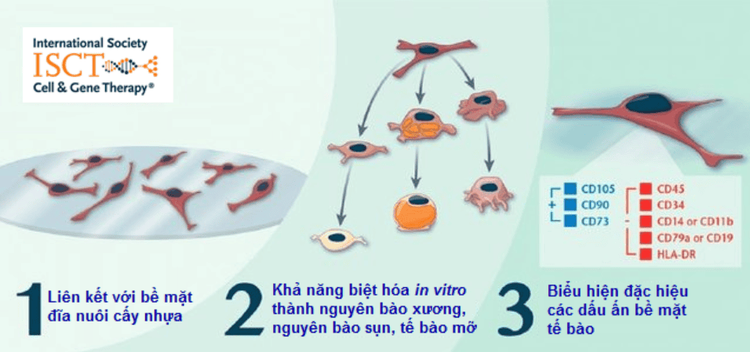
3.2. Purity, avoid contamination One of the important parameters of cell culture and storage process is to assess that the sample is not contaminated with microbial and viral agents. To ensure this, children were screened for common viruses such as HIV (causing immunodeficiency syndrome), HBV (causing hepatitis B), HCV (causing hepatitis C),... at the time of collection. milk tooth. In case of necessity or doubt, pre-storage cell samples are tested for further evaluation. In addition, tests for bacteria and fungi are regularly performed during culture and before storage to ensure sample quality.
3.3. Evaluation of cell karyotype Except for the simplest life forms such as viruses or bacteria, in the nucleus of every organism there are chromosomes, which contain genetic material that determines the characteristics of the organism. as well as pass it on to the next generation. Each species has a unique set of chromosomes, for example in humans there are 23 pairs of chromosomes (half from the father, half from the mother), with 22 pairs of autosomes, 1 pair of autosomes. gender and sex-related characteristics (in men it is XY, in women it is XX). When a cell encounters abnormalities in chromosome number or structure, it can function abnormally and out of control, potentially causing tumors. Therefore, cell samples need to be determined to have a stable chromosomal set during culture and before storage.
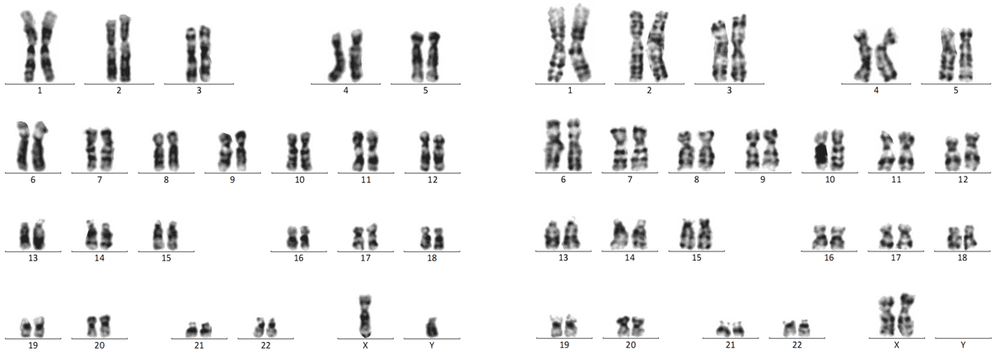
In humans, most cells (except eggs and sperm) contain 23 pairs of chromosomes, with 22 pairs of autosomes and 1 pair of sex chromosomes: XY in males (left), XX in females world (right image)
Currently, Vinmec Times City International General Hospital is the first and only facility in Vietnam to open the service of collecting and storing stem cells from milk tooth pulp. The estimated cost for the whole process from sample collection, stem cell separation and stem cell storage from baby tooth pulp is similar to that of cord stem cell isolation, culture and storage.
Interested customers can contact Vinmec Times City International General Hospital for service.
Please dial HOTLINE for more information or register for an appointment HERE. Download MyVinmec app to make appointments faster and to manage your bookings easily.
References
Zeitlin B.D. (2020). Banking on teeth–Stem cells and the dental office. biomedical journal . Bates K., and Gallicchio V.S. (2021). Dental Stem Cell Banking and Applications of Dental Stem Cells for Regenerative Medicine. In Novel Perspectives of Stem Cell Manufacturing and Therapies . IntechOpen. Hilkens P., et al. (2016). Cryopreservation and banking of dental stem cells. Biobanking and Cryopreservation of Stem Cells , 199-235. Alomar R.K., et al. (2020). A prospective Saudi stem-cell bank from the perspective of the public and dental practitioners: A cross sectional survey. Journal of family medicine and primary care , 9 (2), 864.
